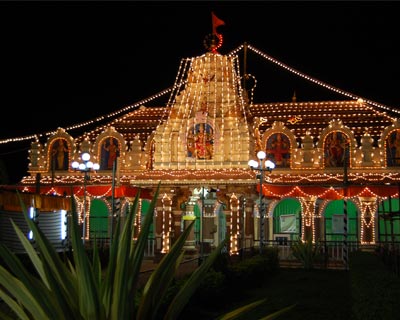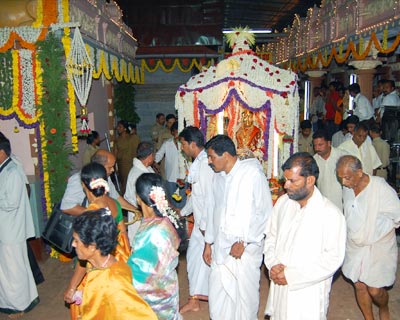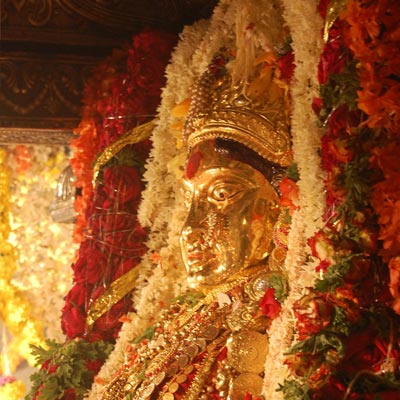0820-2551626
History
Sri Hosa Marigudi Temple : History of Temple
Since ancient times Kaup is known as “Hoovina Hitthilu”. Sri Mariyamma Devi, who is the owner of said place, has been blessing the devotees who come there.
Indian culture is co-ordination of Saindhava & Vedic cultu res, & Folk mentality is its breath. ‘The worship takes place not because there is the presence; but presence may occur while worshiping’ is a folk belief Based on this dedication our religious practices, rites, rituals have passed through centuries and now in this form before us. Though they have changed their forms they have preserved their originality.

It is the opinion of inventors and Think – tanks that almost all of our worshiping mode, which passed through various stages, are now in the evolved form, have come out of folk sources. The object of this article is to make known clearly about the appearance of Mariyamma Kaup, Maari – Mariyarnma, Mariyamma Goddess of Udupi District of Coastal Karnataka.
It is common in various of Udupi, Dakshina Kannada Districts, where there are Tulu speaking people, Pancha Daivasthanas, lots of Daivas (Ghosts) have settled and get worshipped everyw here. It is worth noting that the idea of Maari & Anusandhana are in custom socially only.

Dandina Mari
Kaup is a place formerly governed by many Kings and Emperors. It is historically famous that she settled as Dandina Mari at Kaup, fulfllling devotees wishes by being in the throne of this place. Mariyamma is the icon of power, who got the name “Kapudappe” (“Mother of Kaup”), as she, through her Messenger, Ucchangi, availed victory to People who leave for battles after visiting Mariyamma. Influenced by God Sri Laxmijanardana who is the owner of land of Kaup, Mari being, a great mother, as ‘Mother of Truth” (Sathyadappe) to people who lead life truthfully, ‘Sharanu Durge’ to people come to here as suppliant, is glittering here. Tuesday is favourite day of Mariyamma, and the ocean of devotees visiting here to see the Goddess is evidence of the same. Maripooja (Mari ‘Worship), Chandika Yaga, Gaddige pooje (Throne worship), Thulabhara Sevas which will be performed on Tuesday in the presence of Mariyamma, who will be present will the Gaddige (Throne), have gained great importance. Dates have been fixed for the next seven to eight years for performing Mari Pooja Vow in the presence of Goddess. On the Occasion of every Mari Pooja seasons Gaddige Poojas Get dedicated by way of vow to the Mariyamma Devi blessing the devotees by being on the throne (Gaddige) Poojas get dedicated by the way of vow to the Mariyamma Devi blessing the devotees by being on the throne. The Great Mother suggests solutions to the toil and sorrows of people of all religions, and is, therefore, is known as ‘Thrayambakeshwari’ or ‘Mangalambike’.
Throne Pooja, which is very significant in the presence of Mariyamma, Kumkumarchane, Hoovina Pooje etc. services are also done in great numbers. People from all levels of the Society keep themselves engaged in one or other activities on every Tuesday in the presence of Marikambe. Thousands of people emotionally participate in the mass feeding (Annadhana) organized on every Tuesday. Term Maripooja, performed 3 times in a year, the terminal Maripooja is well known as one of the seven Famous festivals ofTulunadu, which is a creation of Parashurama. Hence, at the time of terminal Mari Poojas that would be performed during Suggi (Spring) Aati and Jaarde, ocean of people flows, not only from South Canara, Udupi, Kasaragod & Mountain Districts, but also from far away place, Mumbai.
Every year, Sharannavarathri Festival would be conducted, and so as to make all nine days attractively, every day many religious and cultural programmes are being organized in the presence of Goddess. The Chandika Yaga, Mass Feeding and the Sri Devi Darshana Seva have- made the power of the sacred place of “Mother of Kaup Mariyamma” very famous everywhere. 9 days since the beginning of the. Atumn, Ashweeja Month, bright half of a lunar month are called ‘Navarathri’ (Nine Nights), and lOth day is called ‘Vidya Dashami’ & ‘Vijaya Dashami’. The time, when the mother nature is shining, and who is compared to the Goddess and worshipped, is called_’Sharannavarathri’. During navarathri 9 Goddesses are invoked to come enter by use of Power Mantras and are then worshipped. It is the belief of the devotees that if the Goddess is worshipped in the manner practiced during 9 days by Aavahana , Aasana, Paadya, Achamana, Snaana, Vastra, Dhoopa, Deepa, Naivedya, Pradakshina, Namaskara, Prarthana which are shodashopacharas, the Goddess would solve the problems and would fulfill the wishes. Sri Mariyamma is worshipped during Sharannavarathri also as “Sri Durga Devi”, “Sri Arya Devi”, “Sri Bhagavathi Devi”, “Sri Kumari Devi”, “Sri Ambika Devi” “Sri Mahishamardhini Devi”, & “Sri Moola Devi”. The administrative board has formed a Renovation Committee, consisting of important persons of the place and devotees, for the purpose of renovating suiting the coastal culture. The Sri Hosamarigudi Temple Kaup, which is situated near the National Highway 66. The Committee which has started developing Mariyammas vicinity, has planned to reconstruct the Auditorium, sanctorum and enclosing wall. Many down – trodden of the society are being given financial assistance from the Fund of Mother of Kaup, Mariyamma. The social- welfare programmes organized by Associations, Institutions are also being given co-operation. Thus, an attempt to support the guidance of elders that the Temples, while sustaining the religious culture, shall also have social – welfare awareness, is also being made.
Ritual of Mari Pooja

